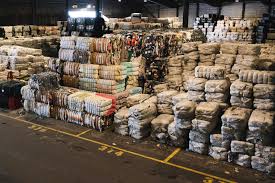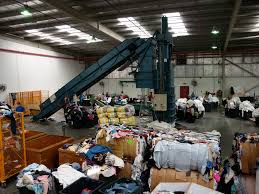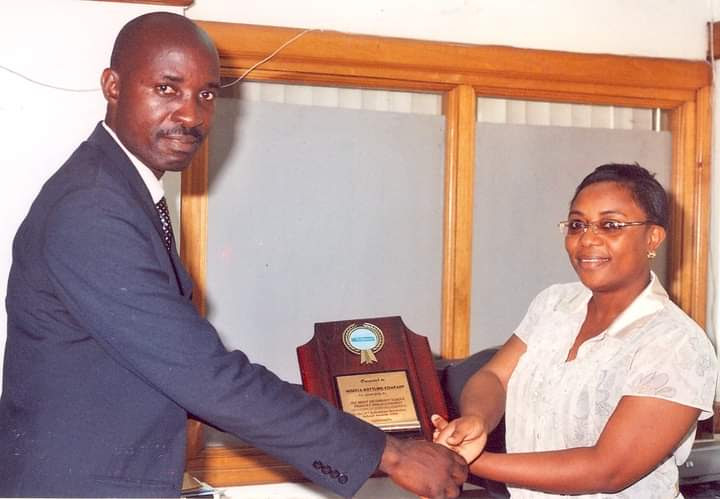![]()
If you’ve landed on this article page, you’re probably searching for a
good business idea—an idea that’s light on the pocket but heavy on
returns, promising both a fulfilling journey and potential profit.
|
How to start a Clothing Recycling Business in Nigeria
The Clothing Recycling Business in Nigeria and Africa involves
the sustainable collection, sorting, and processing of used
textiles and garments to extend their lifecycle and reduce
environmental impact. To establish this business, thorough
research on local clothing consumption patterns, waste
generation, and recycling technologies is essential. The setup
period may vary, but typically includes obtaining necessary
licenses, setting up collection points, and establishing
processing facilities.
Uses Of Recycled Clothing In Nigeria and Africa
1. Recycled Clothing for Local Markets: Recycled clothing can be
sold in local markets, providing affordable and sustainable
options to communities. This contributes to reducing the demand
for new clothing and helps lower the environmental impact of the
fashion industry.
2. Textile Production: Recycled clothing can serve as a valuable
source of raw materials for textile manufacturers. Textiles can
be repurposed into new fabrics for various applications,
including clothing, upholstery, and accessories.
3. Insulation Material: Recycled clothing can be transformed
into insulation material used in construction. This eco-friendly
alternative contributes to energy efficiency in buildings.
4. Cleaning Cloths and Rags: Textiles that are no longer
suitable for wear can be repurposed into cleaning cloths and
rags, extending their usefulness and reducing waste.
5. Arts and Crafts: Recycled clothing can be used by artisans
and crafters to create unique and creative products, adding
value to discarded textiles.
6. Donations and Charitable Initiatives: Recycled clothing can
be donated to charitable organizations, helping to clothe
underserved communities and those in need.
7. Industrial Applications: Certain types of recycled clothing
can be used in industrial applications, such as automotive and
manufacturing sectors, as soundproofing material or for cleaning
purposes.
8. Non-Profit Organizations: Recycled clothing can support
non-profit initiatives that aim to empower vulnerable
populations through vocational training and job opportunities.
9. Fashion Design: Recycled clothing can be used by fashion
designers to create upcycled and sustainable fashion
collections.
10. Export Markets: Recycled clothing can be exported to
international markets where there is a demand for second-hand
clothing, contributing to local economic growth.
1. Upcycled Fashion Brands: Upcycling involves transforming
discarded clothing into new, higher-value fashion products,
promoting creativity and sustainability in the fashion industry.
2. Clothing Repair and Alteration Shops: These businesses focus
on repairing and altering used clothing, extending their
lifespan and reducing the need for new purchases.
3. Vintage and Secondhand Stores: Vintage and secondhand
clothing stores curate and sell pre-owned clothing, contributing
to circular fashion consumption.
4. Textile Recycling Facilities: These facilities specialize in
recycling textiles to extract fibers for creating new clothing
or other textile products.
5. Clothing Collection and Sorting Centers: Collect and sort
used clothing for redistribution, resale, or recycling, ensuring
proper categorization for optimal reuse.
6. Online Clothing Swapping Platforms: Digital platforms
facilitate the exchange of used clothing among individuals,
reducing waste and promoting sustainable fashion.
7. Textile Waste Collection Drives: Organize events or campaigns
to collect used clothing from communities, schools, or
workplaces for recycling.
8. Fashion Design Schools and Workshops: These institutions
teach students sustainable fashion practices, including
recycling and upcycling techniques.
9. Fashion Rental Businesses: Clothing rental services offer
access to high-quality clothing for special occasions, reducing
the demand for new garments.
10. Community-Based Recycling Initiatives: Collaborative efforts
within communities to collect, repurpose, and redistribute
clothing to benefit local residents.
11. Clothing Remanufacturing Companies: Remanufacturing involves
disassembling used clothing and reconstructing it into new
garments or products.
12. Eco-friendly Fiber Production: Businesses that produce
sustainable fibers from recycled clothing materials,
contributing to circular fashion production.
13. Non-Profit Clothing Recycling Organizations: NGOs and
non-profits focused on collecting, recycling, and distributing
used clothing to underserved communities.
14. Clothing and Textile Upcycling Workshops: Host workshops to
teach people how to upcycle and transform used clothing into
unique fashion items.
15. Circular Fashion Consulting Services: Consultants advise
fashion brands on implementing circular fashion practices,
including recycling and sustainable design.
Step 1: Research and Market Analysis: Begin by conducting
thorough research on the clothing recycling industry in Nigeria
and Africa. Analyze the current market trends, competition, and
target audience. Identify the types of clothing that are in
demand for recycling and understand consumer preferences.
Step 2: Business Plan Development: Create a comprehensive
business plan outlining your goals, strategies, target market,
financial projections, and operational plan. This plan will
serve as a roadmap for your clothing recycling business and help
attract potential investors or partners.
Step 3: Legal and Regulatory Compliance: Register your clothing
recycling business with the appropriate government authorities.
Obtain any necessary licenses or permits to operate legally.
Familiarize yourself with environmental and recycling
regulations in Nigeria and Africa.
Step 4: Collection and Sorting Infrastructure: Set up a
collection system to gather used clothing. Establish collection
points in strategic locations, partner with local communities,
or collaborate with existing clothing retailers. Create a
sorting facility to categorize clothing based on quality, fabric
type, and condition.
Step 5: Recycling and Upcycling Techniques: Invest in machinery
and equipment required for clothing recycling and upcycling
processes. This may include shredding machines, sewing
equipment, and dyeing facilities. Explore innovative techniques
to transform old clothing into new and valuable products.
Step 6: Design and Production: Collaborate with designers to
create new clothing items or accessories using recycled
materials. Develop a range of upcycled products that appeal to
your target market’s tastes and preferences.
Step 7: Marketing and Branding: Build a strong brand identity
for your clothing recycling business. Develop a compelling
marketing strategy that highlights the environmental benefits of
your products. Utilize social media, eco-friendly events, and
partnerships to promote your brand.
Step 8: Distribution and Sales Channels: Establish efficient
distribution channels to make your recycled clothing products
accessible to consumers. This may involve partnering with local
retailers, setting up an online store, or participating in
eco-conscious markets and exhibitions.
Step 9: Educational Campaigns: Raise awareness about the
importance of clothing recycling through educational campaigns.
Engage with schools, communities, and organizations to promote
sustainable fashion practices.
Step 10: Monitoring and Evaluation: Regularly assess your
business’s performance, track sales, and gather customer
feedback. Continuously improve your processes, products, and
marketing strategies based on insights gained from monitoring
and evaluation.
Types Of Clothing Recycling Methods In Nigeria and Africa
1. Upcycling and Repurposing: Transform old clothing items into
new and valuable products by creatively altering their design,
shape, or purpose. Upcycling involves giving a new life to
discarded garments through artistic and innovative methods.
2. Textile Recycling: Process used clothing into raw textile
materials that can be used for making new fabrics, yarns, or
other textile products. This method involves breaking down
textiles into fibers which are then re-spun into new threads.
3. Donating and Charity: Collect gently worn clothes and
distribute them to charitable organizations, NGOs, or
communities in need. This method extends the lifespan of
clothing and benefits those who cannot afford new apparel.
4. Fiber-to-Fiber Recycling: Convert old clothing into new
fibers that can be blended with virgin fibers to create fabrics
for new clothing items. This method reduces the need for virgin
resources and decreases environmental impact.
5. Cloth Cutting and Stitching: Disassemble used clothing into
smaller fabric pieces and sew them together to create new
clothing items. This method minimizes waste and produces unique,
patchwork-style designs.
6. Clothing Swaps and Exchanges: Organize events where people
can exchange their unwanted clothing items with others. This
encourages a culture of sharing and reduces the demand for new
clothing.
7. Vintage and Secondhand Stores: Curate a collection of
high-quality, pre-loved clothing items for resale. Vintage and
secondhand stores provide a sustainable alternative to buying
new garments.
8. Rag and Fiber Processing: Sort old clothing into different
categories based on fabric type and quality. Process low-quality
fabrics into industrial rags or other textile applications.
9. Rental and Subscription Models: Create platforms where
customers can rent clothing for a specific period or subscribe
to a rotating wardrobe. This reduces the need for constant new
purchases.
10. Craft and Artistic Projects: Encourage artisans and
designers to use discarded clothing as raw materials for
crafting unique products, such as bags, accessories, or home
decor items.
11. Textile Shredding and Blending: Shred used clothing into
small pieces and blend them with other fibers to create new
fabrics or non-woven materials.
12. Fabric Dyeing and Printing: Apply dyeing and printing
techniques to transform old clothing into vibrant, new designs.
This adds value to the recycled garments.
13. Eco-Friendly Cleaning Products: Process old clothing to
create natural, reusable cleaning cloths, reducing the need for
disposable paper towels.
14. Insulation and Filling Materials: Convert old clothing into
insulation materials for buildings or stuffing for pillows,
mattresses, and upholstery.
15. Quilting and Patchwork: Use small fabric pieces from old
clothing to create quilts, blankets, or patchwork-style clothing
items.
How To Recycle and Package Clothing In Nigeria or Africa
1. Collection and Sorting: Set up collection points or bins in
communities, schools, or public areas to gather used clothing.
Sort collected clothing based on quality, fabric type, and
condition.
2. Inspection and Grading: Thoroughly examine the collected
clothing to determine their usability. Grade items into
categories like “like new,” “gently worn,” or “worn.”
3. Cleaning and Sanitization: Wash and sanitize the clothing to
remove dirt, stains, and odors. This step ensures that recycled
clothing meets hygiene standards.
4. Repair and Restoration: Mend minor damages such as loose
threads, missing buttons, or small tears to extend the lifespan
of the clothing.
5. Upcycling and Repurposing: Transform worn or outdated
clothing into new and stylish products by altering their design,
adding embellishments, or combining different garments.
6. Fabric Shredding and Fiber Extraction: For items beyond
repair, shred the fabric to extract fibers. This can be used to
create new textiles or other materials.
7. Textile Recycling: Convert shredded textiles into raw
materials like yarns or fibers, which can be blended with virgin
materials to produce new fabrics.
8. Design and Creation: Use the recycled fabrics to design and
create new clothing items or accessories, taking into account
current fashion trends and consumer preferences.
9. Quality Control: Ensure that the recycled clothing items meet
quality standards and are free from defects before they are
ready for distribution or sale.
10. Packaging and Presentation: Pack the recycled clothing items
in eco-friendly packaging, highlighting their sustainable and
recycled nature.
11. Marketing and Branding: Develop a strong brand identity that
communicates the eco-friendly and socially responsible aspects
of your clothing recycling business.
12. Distribution and Sales: Choose suitable sales channels such
as retail stores, online platforms, or pop-up markets to make
the recycled clothing accessible to customers.
13. Community Engagement: Educate the community about the
benefits of clothing recycling and encourage their participation
through workshops, events, and campaigns.
14. Partnerships and Collaborations: Collaborate with local
artisans, designers, and organizations to create unique products
and expand market reach.
15. Monitoring and Feedback: Regularly assess the impact of your
clothing recycling efforts, gather feedback from customers, and
make necessary improvements to enhance the business.
Raw Materials Used To Recycle Clothing In Nigeria or Africa
1. Used Clothing: Collected second-hand clothing serves as the
primary raw material for clothing recycling, sourced from
donations, collection bins, or thrift stores.
2. Fabric Scraps and Offcuts: Leftover fabric scraps and offcuts
from garment manufacturing or tailoring are valuable inputs for
creating new clothing items.
3. Textile Waste: Discarded or damaged textiles from households,
factories, or retail stores can be repurposed into new clothing
through recycling.
4. Unwanted Garments: Clothing items that are no longer in use
or in good condition, including outdated fashion, can be
salvaged for their fabrics.
5. Unsold Inventory: Unused stock from fashion brands or
retailers, including overstock, unsold products, or samples, can
be repurposed into new designs.
6. Post-Consumer Textiles: Worn-out clothing from consumers,
such as torn or faded garments, can be collected and recycled.
7. Donated Clothes: Donated clothing from individuals or
organizations provides a consistent source of raw materials for
clothing recycling.
8. Damaged Apparel: Clothing items with minor damages that are
otherwise unsellable can be dismantled for their usable parts.
9. Outdated Fashion: Out-of-trend clothing is deconstructed to
retrieve the fabrics, buttons, zippers, and other components for
recycling.
10. Textile Waste from Manufacturing: Unused or surplus
materials generated during the manufacturing process, including
cuttings and trimmings, can be repurposed.
11. Upholstery and Linens: Old upholstery fabrics, bed linens,
and curtains can be transformed into new clothing items through
recycling.
12. Scrapped Clothing: Clothing rejected during quality control
in manufacturing due to defects or inconsistencies can be used
as raw materials.
13. Post-Production Scraps: Leftover fabrics, threads, and
trimmings from garment production are repurposed into new
designs.
14. Damaged Textiles: Textiles damaged during transportation,
storage, or handling can be reprocessed into new clothing
products.
15. Thrifted Clothing: Clothing sourced from thrift stores or
second-hand markets provides a diverse range of materials for
recycling.
Types Of Equipment & Tools Used In The Clothing Recycling
Business In Nigeria or Africa
1. Sorting Equipment: Used to segregate different types of
clothing based on color, fabric, and condition for efficient
recycling.
2. Shredder and Granulator: For processing textile waste into
smaller fibers, preparing them for further processing.
3. Carding Machine: Used to align and blend fibers to create a
uniform material suitable for spinning into new yarn.
4. Spinning Machine: Converts recycled fibers into yarns that
can be used for weaving or knitting new fabrics.
5. Knitting Machine: Creates fabrics from yarns, producing
various textures and patterns for new clothing items.
6. Weaving Loom: Produces woven fabrics from recycled yarns,
offering a wide range of options for garment production.
7. Cutting and Sewing Machines: Used to transform recycled
fabrics into finished clothing products through cutting and
stitching.
8. Embroidery and Embellishment Machines: Add decorative
elements to recycled clothing items, enhancing their aesthetic
appeal.
9. Printing Equipment: Applies patterns, designs, or logos onto
recycled fabrics, creating unique clothing pieces.
10. Ironing and Pressing Machines: Ensures the finished clothing
items are properly pressed and presentable.
11. Labeling and Tagging Machines: Adds labels, tags, and care
instructions to recycled clothing products.
12. Packaging Equipment: Enables efficient packaging of recycled
clothing items for distribution and sale.
13. Sewing Supplies: Includes needles, threads, buttons, and
zippers used in repairing and upcycling garments.
14. Quality Control Tools: Equipment for inspecting recycled
clothing items to ensure they meet quality standards.
15. Storage and Transportation Equipment: Facilitates the
movement and storage of recycled clothing products within the
supply chain.
The Clothing Recycling business holds significant promise as a
catalyst for sustainability and economic growth across Nigeria
and Africa. Through its commitment to reducing environmental
impact and promoting responsible consumer behavior, this
industry can play a pivotal role in addressing pressing
ecological concerns. By diverting clothing from landfills and
incineration, the business contributes to waste reduction and
minimizes the carbon footprint associated with textile
production.
Furthermore, the Clothing Recycling business has the potential
to create employment opportunities, especially within local
communities where the collection, sorting, and processing of
discarded clothing can generate income and support livelihoods.
This socio-economic impact extends to various sectors, fostering
economic resilience and empowering individuals.
However, the journey toward establishing a thriving Clothing
Recycling business is not without its challenges. Overcoming
ingrained consumer behaviors and perceptions, developing
efficient collection and sorting infrastructure, and
establishing reliable distribution channels are all essential
aspects that require strategic planning and collaboration among
stakeholders.
By leveraging technological advancements and strategic
partnerships, the Clothing Recycling business can overcome these
hurdles and harness its potential for a sustainable future.
Education campaigns, innovative sorting and processing
techniques, and collaborations with local artisans are all
avenues to foster greater acceptance and utilization of recycled
clothing. This, in turn, can contribute to the broader goal of a
circular economy, where resources are conserved, waste is
minimized, and economic growth is realized in harmony with the
environment.
Get our Practical Guide on How to start a Clothing Recycling
business in Nigeria. This comprehensive guide will walk you
through the fundamentals of starting and running a successful
Clothing Recycling business in Nigeria, from initial
planning to profitability. We’ll cover key factors like
identifying in-demand niches, establishing a strong brand,
marketing effectively, optimizing operations and delivering an
exceptional student experience.
|







